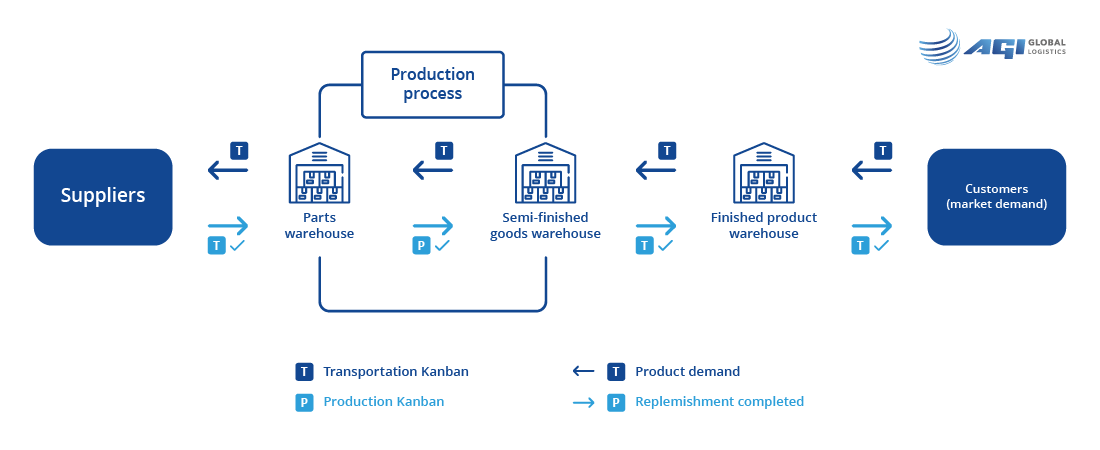You may have heard the phrase ‘Just-In-Time (JIT) delivery’, but what is it? It is an essential concept in the world of supply chain management, whether you’re a seasoned logistics expert or just dipping your toes into the freight forwarding waters, understanding JIT delivery is crucial in optimising your operations.
In this comprehensive guide, we’ll explore the definition, history, impact, benefits, challenges, and techniques surrounding JIT delivery.
What is Just In Time (JIT) Delivery?
Just-In-Time delivery, commonly known as JIT, is a logistics strategy aimed at minimising inventory storage costs and improving overall efficiency. The primary goal of JIT is to ensure goods arrive precisely when they are needed, neither too early nor too late. This precise timing helps reduce the amount of excess inventory held in warehouses, thus minimising the associated holding costs.
The central principle of JIT revolves around the concept of “pull” instead of “push” production. In other words, goods are produced or delivered in response to actual demand, rather than being pushed into the market based on forecasted demand.
Key Concepts of Just In Time Delivery
Minimising Waste: JIT is all about eliminating waste in the supply chain. This includes excess inventory, overproduction, waiting times, and unnecessary transportation. By operating on a “just in time” basis, businesses reduce wasteful practices and optimise resources.
Lean Manufacturing: JIT delivery is closely tied to the concept of lean manufacturing, which aims to streamline processes, reduce costs, and improve efficiency by eliminating anything that doesn’t add value to the final product or service.
Kanban System: The Kanban system is a visual method used in JIT delivery to manage inventory levels and production flow. It uses cards or signals to indicate when new inventory is needed, ensuring a smooth and efficient production process.

Continuous Improvement: JIT is not a one-time implementation. It’s a continuous improvement process. Businesses must constantly analyse and refine their processes to identify areas for optimisation and efficiency gains.
The History of JIT Delivery
The JIT concept emerged in Japan during the 1970s and quickly revolutionised manufacturing processes. Toyota, the Japanese automotive giant, pioneered the implementation of JIT delivery in its production system. The company sought to eliminate waste, enhance production flexibility, and deliver higher quality products with shorter lead times.
The success of Toyota’s approach attracted attention worldwide, making JIT an influential and widely adopted logistics strategy!
How Does Just In Time Delivery Affect Supply Chain Management?
JIT delivery plays a crucial role in supply chain management. By streamlining the flow of goods, it helps reduce lead times, inventory levels, and associated holding costs. Supply chain partners collaborate closely to ensure that each component or product arrives precisely when needed for the next stage of production or sale.
Efficient communication and coordination are vital for successful JIT implementation, enhancing overall supply chain responsiveness.
Can Just In Time Inventory Management Reduce Costs?
Absolutely! JIT inventory management significantly reduces holding costs associated with excess inventory. Warehousing expenses, insurance costs, and the risk of obsolescence all decrease as inventory levels are optimised.
Additionally, a JIT approach minimises the need for large storage facilities, freeing up resources for other critical aspects of your business.
Benefits of JIT Delivery
Implementing Just-In-Time (JIT) delivery offers a wide range of benefits for businesses, enabling them to optimise their supply chain operations and gain a competitive edge in the market. Let’s delve deeper into the advantages of adopting JIT:
Cost Efficiency: One of the primary advantages of JIT delivery is its ability to significantly reduce inventory costs. By maintaining minimal inventory levels, businesses can avoid the expenses associated with warehousing, storage, insurance, and handling. Plus, with JIT’s “pull” approach, production is based on actual demand, preventing overproduction and minimising the risk of holding obsolete or slow-moving inventory.
As a result, companies can allocate resources more efficiently, leading to substantial cost savings over time.
Enhanced Quality Control: JIT delivery fosters a culture of continuous improvement and quality control throughout the supply chain. With smaller, more frequent deliveries, businesses can inspect incoming goods more rigorously, ensuring that each component or product meets the required quality standards.
This means defects or issues can be promptly addressed before they escalate, reducing the likelihood of faulty products reaching the customer.
Flexibility and Responsiveness: In today’s fast-paced business landscape, the ability to adapt swiftly to market changes is crucial. JIT delivery enhances supply chain agility, allowing businesses to respond quickly to fluctuations in demand or unexpected disruptions.
By synchronising production and delivery with actual market requirements, companies can avoid stock outs during peak demand periods and minimise excess inventory during slower times.
Reduced Lead Times: Shortening lead times is a significant advantage of JIT delivery. Products can move through the supply chain more quickly, resulting in faster delivery to customers. This quick turnaround time can lead to improved customer satisfaction and increased loyalty.
JIT also enables businesses to offer shorter delivery times, which can be a competitive advantage in today’s e-commerce-driven world.
Streamlined Processes: JIT delivery necessitates a close collaboration between suppliers, manufacturers, and distributors. As a result, communication and coordination between supply chain partners are enhanced.
Businesses can streamline processes, eliminate bottlenecks, and reduce unnecessary paperwork, leading to smoother operations and improved overall efficiency.
Waste Reduction: As previously mentioned, JIT is inherently linked to the concept of lean manufacturing, which focuses on eliminating waste and optimising resources. By minimising excess inventory and reducing the risk of overproduction, JIT helps companies operate more sustainably.
This waste reduction not only benefits the bottom line but also aligns with environmentally conscious business practices.
Competitive Advantage: Embracing JIT delivery can set businesses apart from their competitors. Shorter lead times, better quality control, and improved customer responsiveness can give companies a significant edge in the market.
As customer expectations continue to evolve, implementing JIT can help retain existing customers and attract new ones.
Employee Engagement: JIT delivery encourages a culture of teamwork and continuous improvement within the organisation. Employees become actively involved in the efficiency of the supply chain, leading to increased engagement and a sense of ownership in their roles.
This employee involvement can contribute to a positive work environment and higher job satisfaction.
Problems with JIT Delivery
While Just-In-Time (JIT) delivery offers numerous benefits, it is not without its challenges. Businesses considering the implementation of JIT must be aware of the potential issues and take proactive measures to mitigate them.
Here are some common problems associated with JIT delivery:
Supply Disruptions: Relying heavily on timely deliveries can lead to disruptions if suppliers encounter issues.
Transportation Risks: Transportation delays can impact JIT schedules, leading to production bottlenecks.
Increased Reliance on Suppliers: JIT requires a strong and reliable network of suppliers, making it vital to establish strong relationships.
Vulnerability to Demand Fluctuations: Unexpected spikes in demand may strain JIT systems, requiring agile adjustments.
Techniques for Successful JIT Delivery
Implementing Just-In-Time (JIT) delivery requires careful planning and a well-coordinated approach. To ensure the successful adoption of JIT principles in your supply chain, consider these essential techniques:
Effective Communication: Keep supply chain partners well-informed about requirements and changes in demand.
Continuous Improvement: Regularly review processes to identify areas for optimisation and efficiency gains.
Collaborative Relationships: Build strong partnerships with suppliers, fostering mutual trust and commitment.
How to Implement JIT Processes
Implementing Just-In-Time (JIT) processes in your supply chain requires a well-thought-out strategy and commitment from all stakeholders involved. Consider the below to help you successfully adopt JIT principles:
Assessment: Analyse your current supply chain and identify areas where JIT principles can be applied.
Supplier Selection: Choose reliable suppliers who can meet JIT demands consistently.
Technology Integration: Leverage technology, such as supply chain management software, to enhance communication and visibility.
In conclusion, Just-In-Time (JIT) delivery is a powerful logistics strategy that can transform your supply chain operations. By minimising inventory costs, enhancing flexibility, and improving overall efficiency, JIT can help your business thrive in today’s dynamic market.
Here at AGI Global Logistics, we understand the significance of JIT delivery in optimising your supply chain. Our expert team is dedicated to providing reliable and efficient freight forwarding services tailored to your specific needs. Contact us today to explore how we can help streamline your logistics processes and drive your business to new heights!
Remember, embracing JIT is a step towards a more sustainable and profitable future for your business. Stay ahead of the curve with the power of Just-In-Time delivery!
